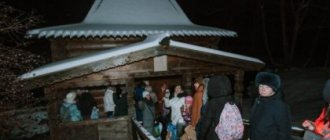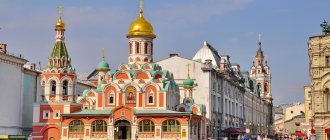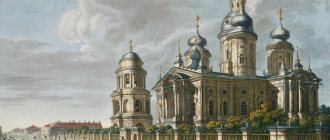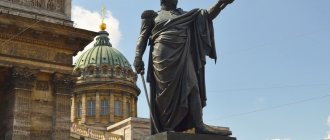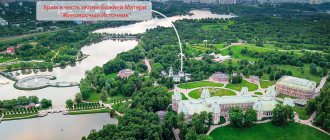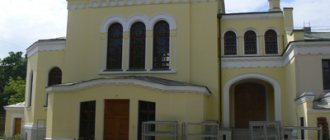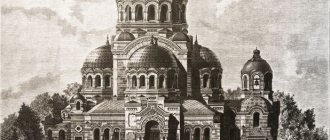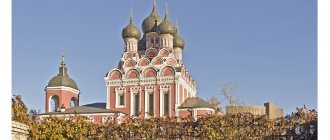The Church of the Vladimir Icon of the Mother of God is an Orthodox church that has an amazing history and unusual architectural style. The church is a monument of Russian Gothic and is considered one of the best examples of Russian architecture and landscape art of the late 18th century.
© Ludvig14
The Vladimir Church in Bykovo consists of two churches: the upper one (in honor of the Vladimir Icon of the Mother of God) and the lower one (the Nativity of Christ). The facades of the building are decorated with round bas-relief medallions, on which you can see the Izmailov family. The temple itself, with two symmetrical towers with spiers and pointed arches, is lined with white stone. A double-sided staircase leads to the main entrance, which also serves as an archway to enter the lower part of the church.
The sacraments of baptism and weddings take place in the Church of the Vladimir Icon of the Mother of God. Conversations before the sacraments take place on Saturdays at 15:00.
On the basis of the Vladimir Church in Bykovo there is a Sunday school in memory of the Resurrection of the Lord, where children are educated spiritually. The school hosts readings of the Holy Scriptures - the Bible and the study of the Law of God, Church History, Orthodox dogma, church singing, and Orthodox etiquette. It will help fill children's souls with the knowledge of Jesus and distract them from the street and gadgets. Classes are held on Sundays from 11:30 to 14:00 for three age groups: preschool (4–6 years), primary (7–10 years), basic (11–14 years). The Sunday School also conducts classes on handicrafts, woodworking and aircraft modeling, organizes performances and holidays, excursions, and pilgrimage trips to holy places.
© Sergey Vasilets
Excursion
Tourists regularly come to the Church of the Vladimir Icon of the Mother of God. The peaceful atmosphere attracts a large number of visitors who can visit the temple, attend services and enjoy the local atmosphere.
People regularly come to the church for the sacraments of baptism and weddings, as it is very beautiful and secluded.
You can visit the Vladimir Church in Bykovo daily from 08:00 to 17:00.
© Shish_ka
Current state[edit]
Interior The
area surrounding the temple is occupied by a cemetery.
Activities of the parish:
The church has a school for children and adults, a library, a singing club, and provides charitable assistance.
Phones:
Adm. Vladimirskaya"
— September 8, July 6, June 3
Nicholas the Wonderworker, Archbishop of Myra, Saint
— May 22, December 19
Sergius of Radonezh, Venerable
— Cathedral of Moscow Saints, July 18, October 8
History of the Vladimir Church in Bykovo
The Church of the Vladimir Icon of the Mother of God was built in the late 80s of the 18th century in a pseudo-Gothic style on the territory of the Bykovo/Maryino estate by the decision of the owner of these lands, Mikhail Izmailov. At the beginning of the 17th century, there was a wooden church on this site, but in 1707 a stone temple was erected here, which over time became a two-story church.
In the 1830s, a free-standing bell tower was built next to the church, in the same style as the church. In the 1930s, the church was looted and closed, and a garment factory and then a warehouse were located on its territory. In 1989, the church was returned to the Russian Orthodox Church.
On the western side there are columns and two towers with bells: one is for ringing, the other is for the clock. On the facade of the church you can see bas-reliefs depicting Mikhail Mikhailovich and Maria Alexandrovna.
At the end of the 80s of the 20th century, the church was transferred to the community of believers, and at that moment the restoration of the building began. The temple became operational again.
Today, the white stone church has no similar analogues in the entire Moscow region; it is very popular for visiting.
© Shish_ka
The emergence of the church
The history of the cathedral began in the 18th century. After the founding of St. Petersburg, servants and craftsmen of the Imperial Court settled across the Fontanka River. The place of their settlement was called Dvortsovaya Sloboda .
In 1746, in the house of Fyodor Yakimov, an employee of the Palace Chancellery, a prayer temple with a linen camp iconostasis was built, where townspeople living in the area came. Soon a small wooden church , which quickly fell into disrepair.
Then the residents turned to Empress Elizabeth Petrovna with a request to build a new building. The collection of funds for the new church from parishioners and patrons of the arts was led by the rector John Kirikov.
In 1761, long-awaited construction began in Dvortsovaya Sloboda, designed by architect Pietro Trezzini. The lower church was opened in 1769, the upper one in 1783. For the consecration of the stone church, Empress Catherine II gave the parish the altar Gospel, printed in 1744.
Manor
Not far from the temple is the Bykovo estate, which is a manor complex - an example of Russian architecture and Garden and Park art of the era of Emperor Nicholas I. The complex with a total area of 30 hectares has a park with ponds, a manor house, and a rotunda gazebo of the 18th century. The estate itself, although dilapidated over such a period of time, still has its former grandeur.
You can see the territory of the estate complex for free, but entry into the palace is prohibited.
The Bykovo estate has a rich past. The former owner of the estate, M. M. Izmailov, built a luxurious estate, but subsequently the estate was transferred to Vorontsov-Dashkov, and then to Nikolai Ilyin. After the revolution, the Church of the Vladimir Icon of the Mother of God was closed and the workshops of a garment factory were established here. Then the Bykovo estate was nationalized, and then a colony for minors was established, and during the war a school for intelligence saboteurs opened. After the war, a tuberculosis sanatorium was opened on the estate. Today, numerous tourists from all over Russia come to see the estate and the temple.
Bykovo estate complex, © Shish_ka
How to get there[edit]
Address:
Moscow region, Ramensky district, village. Bykovo, st. Kolkhoznaya.
Telephone:
(49646) 2-41-26.
Travel by public transport:
from the Kazansky railway station to the Udelnaya station, then buses No. 23, 39 to the Khram (Club) stop.
Next, walk along the narrow passage between the fences, along which you need to exit onto a parallel street, then turn right, walk a little and turn left. The total walk is about 400 m.
How to get to the Vladimir Church by car:
from Moscow along the Ryazanskoe highway to the turn to Bykovo (via Zhilino) - 8 km, then turn left. Next - travel not to the airport, but to the towns of Bykovo and Zhukovsky. Drive right through Bykovo, at the border between Bykovo and Zhukovsky at the traffic lights turn right, then after 200 m turn right again onto the street. Highway, and drive along it to the Vladimir Church.
Schedule
The Church of the Vladimir Icon of the Mother of God is open daily. Divine services are held on Wednesdays, Saturdays, Sundays and church holidays.
- Morning services begin at 08:00.
- Evening services begin at 16:00.
On weekdays, the temple is open for prayer visits from 08:30 to 16:30.
Schedule of services at the Vladimir Church in Bykovo March 2022
© Of. Resurrection Church Facebook page
Vladimir Icon of the Mother of God Cathedral with bell tower
The interior architectural design has survived to this day. Two iconostases have been preserved - the original (gilded wooden carved), made for the Vladimir Church (now the front part is turned towards the altar) and the three-tiered iconostasis of the Church of the Resurrection of the Slovushchey Anichkov Palace, transferred to the temple, made according to a drawing by F. Rastrelli. Rastrelli's iconostasis consisted of 30 icons, now there are 24 left. The altarpiece of the “Holy Trinity”, a painting in a huge chasuble, which was considered the most valuable, has not been preserved.
Lower Church of St. John of Damascus was amazed by the many ancient icons in silver and gold frames. Already during construction, stoves were installed here, and worship was conducted all year round. The staircase to the upper church was originally located in the refectory.
The upper church is richer in architectural decoration. The central drum is light. The side drums were originally lighted too, but in the 1900s. covered with false vaults. In 1911 the moldings were painted. Currently, the interiors have been restored and the stucco decorations have been cleaned.
The vestibule premises were built by A. Melnikov in 1830-1831.
After the revolutions and the nationalization of church values, the museum department under the Glavnauka took over the protection of antiquities. More than 60 church items were registered as particularly valuable in historical and artistic terms, but in order not to violate the integrity of the ensemble, many were left in the temple. Some of the icons (the image of the Savior, the Tikhvin and Vladimir icons of the Mother of God) were bought by parishioners, but soon many valuables were confiscated. After the church was closed, a significant part of the icons and vestments went to the Hermitage and the Russian Museum.
From the time of Peter the Great, after the decree of 1724, churches had a staff of clergy, and the clerics received salaries from the treasury. It was only in Elizabethan times that churches with a clergy that existed at the expense of the parish began to appear. Among the first such churches was the Vladimir Church.
The Vladimir Church owned a large plot of land in Kuznechny lane, between Yamskaya (Dostoevsky) and Bolshaya Moskovskaya streets.
Back in 1739, by decree of the Emperor. Anna Ioannovna, in the shopping area of the church, 6 places were given for the construction of church yards. Below, an additional plot was purchased on the corner of Bolshaya Moskovskaya Street. and Kuznechny lane. In 1863, a stone clergy house was built. Before this, the clergymen built wooden houses for themselves on church land at their own expense. After moving to a stone house, the wooden houses were demolished, and the vacant space began to be rented out to private individuals for firewood storage. The first stone clergy house was located at Bolshaya Moskovskaya, 4 (four-story), two 4-story outbuildings adjoined the house. In the basement there were petty and tobacco shops and an ironing room. Later, apartments in the building began to be rented.
In 1878, at the corner of Bolshaya Moskovskaya and Kuznechny lane. (Metropolitan building) a four-story stone house was built, in the courtyard there was a two-story stone outbuilding and a one-story stone service. The house was intended for the residence of church clergy; there was a pharmacy on the ground floor. In the outbuilding, some of the apartments were rented out, and some were occupied by “their orphans.”
In 1905, a new five-story apartment building and a 4-story laundry room were built in the courtyard of house 4 on Bolshaya Moskovskaya. The remaining space is on Kuznechny lane. continued to be rented out as wood warehouses. Later, shopping arcades were set up here, and then a market grew.
Since the time of Father John, there has been a wooden house for the clergy, a pond and a well on the church site. In 1891, a two-story outbuilding was built here, in which the church watchmen lived and there was a prosphora.
In 1888, small residential extensions were made to the chapels.
The Manifesto of February 19, 1861, which freed the peasants from serfdom, and the reforms that followed, caused a widespread increase in church and parish charity. In 1865, a charitable society was created at the Vladimir Church, the founders of which were rector A. Sokolov, priests P. Nikitsky, I. Gratinsky, N. Viroslavsky and church elder S. Kudryavtsev. In 1868, the society opened a shelter for elderly women in the old parish house. In the 1880s. The society built its house on Yamskaya street, 1 (Dostoevsky, 1), into which a shelter for 30-40 people was transferred. In 1873, a day shelter for children for 30 people was opened.
In the territory of the parish of the Vladimir Church lived:
In 1823 on Gryaznaya Street. Baron Modest Andreevich Korf, a student of the first graduating class of the Tsarskoye Selo Lyceum, lived in Komarova’s house (site 16-18) (not preserved).
In Svechny lane. A. S. Pushkin’s parents, Sergei Lvovich and Nadezhda Osipovna, lived in Kastorsky’s house (house 5, rebuilt). Pushkin’s sister, Olga Sergeevna Pavlishcheva, lived on Gryaznaya Street. in the house of M. Mordatova (Marata, 25). In March 1828, the poet’s nanny Arina Rodionovna came here from Mikhailovskoye, she died here, her funeral service was held in the Vladimir Church.
In 1826, Anton Antonovich Delvig moved to Kuvshinnikov’s house (section Zagorodny pr., 9). Delvig's apartment became one of the literary centers of St. Petersburg.
In 1826, Anna Petrovna Kern lived first in the apartment of Pushkin’s parents, then in Delvig’s apartment, and later in a small apartment in the same building.
In 1829, Delvig moved to the house of the merchant Tychinkin (Zagorodny Ave., 1). In the same apartment there was also the editorial office of the Literary Newspaper, published by him and Vyazemsky. Delvig died here in 1831. The funeral service was held in the Vladimir Church.
In the 1840s. in the Fredericks house on the corner of Vladimirsky Prospekt (house 13) and Grafsky lane. lived prof. Russian literature A. V. Nikitenko.
On Gryaznaya street. Architect V.P. Stasov lived in Tukholka’s house (23 Marata St.).
In 1850-1854 in Trubnikov’s house on the corner of Kolokolnaya and Povarsky lane. lived N. A. Nekrasov.
At the corner of Vladimirsky Ave., 11 and Grafsky Lane. in 1842-1846 F. M. Dostoevsky lived. In 1878-1881 he lived in a house on Kuznechny Lane, where he died on January 28.
In 1887-1888, the writer V. M. Garshin lived in the house at 5 Povarsky Lane.
In 1883-1889, composer N. A. Rimsky-Korsakov lived in Viktorova’s house at the corner of Vladimirsky Prospekt and Kolokolnaya (18/2).
In 1885-1889, first on Ivanovskaya Street (Socialist), then on Bolshaya Moskovskaya, opposite Svechny Lane. A. Blok's childhood passed.
In 1902-1907 on Razyezzhay Street. lived the writer A.I. Kuprin.
After the decree on the separation of church and state was issued in 1918, all subsequent laws in Petrograd were implemented more slowly than in other cities. So on November 4, 1918, at a meeting of the executive committee of the Council of the 1st city district, the charter of the parish community of the Vladimir Church was approved.
In 1917, Archpriest Pavel Kedrinsky was elected rector. The rights of the community were formalized in 1919. Parishioners received the use of all churches located on the territory of the parish. The parish lost its fixed capital only in 1920. The nationalization of the church's real estate also extended until the autumn of 1920. In 1920, all charitable activities were finally prohibited. From 1921 until the summer of 1922, there were theological courses.
(based on the book by E.V. Isakova, M.V. Shkarovsky, Cathedral on Vladimirskaya
and temples of the court settlement, St. Petersburg, Paritet, 2004, added Mary)
“In 1932... the then address 20 Nakhimson Avenue was transferred to the GPB. Despite the fact that in the initial request for the allocation of this particular building, the library management emphasized that it required minimal investment to adapt to library needs, work on the reconstruction and relocation of funds continued for two years, and the branch opened for readers only in 1934. However, in In April 1941, our funds were urgently evicted to the Church of St. Catherine... This time the Vladimir Church was practically doomed, in its place the ground vestibule of the Prospekt Nakhimson metro station was to appear. However, the war intervened; the ground vestibule of the Vladimirskaya metro station was built later, and literally on the site of a neighboring building.”
(Isakova E.V. Cathedral on Vladimirskaya and the churches of the Court settlement / E.V. Isakova, M.V. Shkarovsky. - St. Petersburg: Paritet, 2004. weigher)
1965: Mechanized counting factory “Lenmashuchet” LGIK - Vladimirsky Ave., 20 ([108]. P. 194)
Given incl. telephone numbers of workshop No. 1 and workshops No. 2 and 3.
1973: Factory of mechanical counting "Lenmashuchet" (association "Lensystemotekhnika") - Vladimirsky Ave., 20 ([211]. P.212)
Miraculous Vladimir Icon of the Mother of God
The cathedral is named after the miraculous icon of the Mother of God, which was brought to St. Petersburg in 1763.
Interesting! According to church tradition, the Vladimir Icon was painted by the holy Apostle Luke.
The evangelist captured a picture seen at the dinner table, at which little Jesus Christ with his Most Pure Mother and Righteous Joseph were eating. The mother's caring arms gently embrace her son, who clings tenderly to her. There is sorrow on Mary’s face.
On the board from the table, Luke depicted what he saw. When the artist brought the icon to the Mother of God, Mary said: “From now on, all my people will bless Me. May the grace of the One born of Me and Mine be with this icon.”
The icon visited Jerusalem and Constantinople. At the beginning of the 7th century, the icon was delivered from Constantinople to Kyiv as a gift to Grand Duke Yuri Dolgoruky from Patriarch Luke Chrysovergus.
Prince Andrei, the son of Yuri Dolgoruky, traveled from the south of Russia to the Rostov region and took the miraculous image with him. While praying in front of the icon, he received instructions from the Mother of God to leave the image in Vladimir. Since then, the icon has been named Vladimirskaya. The Church of the Assumption was founded for her in the city.
Then, by the providence of God, the holy image was transported to Moscow, which needed the protection of the Mother of God. Over the course of the appearance of the miraculous icon, many amazing events related to it occurred:
- At the end of the 14th century, the Mother of God defended Rus' from Khan Tamerlane;
- In the middle of the 15th century, the icon saved the capital from an attack by the Tatars;
- At the end of the 15th century, the battle with the Mongol-Tatars did not take place: Russian soldiers came out to meet the enemy, carrying the icon of the Savior in the front row, and the enemy immediately retreated.
Cathedral altars
The cathedral includes a lower - cold church and an upper - warm one. There are six altars in the cathedral. The lower church is consecrated in honor of the rector of the Valaam monastery John of Damascus, the upper church is dedicated to the Vladimir Icon of the Mother of God.
The remaining thrones are consecrated in honor of the prophet Elijah, the holy martyr Harlampius, the icon “Joy of All Who Sorrow,” the holy martyrs Faith, Nadezhda, Love and their mother Sophia.
Church garden
Behind the cathedral fence there was a church garden, which the organizers used for religious edification. In the garden there are four-column gazebos, each with a gilded dome with the figure of an evangelist.
The gazebo is decorated in such a way that it reflects the main stages of the Savior’s earthly life: the Crucifixion, the Descent from the Cross, the appearance of the risen Savior to Mary Magdalene, the journey to Emmaus.
The gazebos are united by a bronze gilded dome. Between the pavilions a cave was erected, in the dome of which there was a temple surrounded by clouds and golden rays.
Life of the Church after the Revolution
After the revolution, the Vladimir temple was closed to believers. The good building remains intact. To prevent the golden domes from being conspicuous, they were painted over with black paint. An anti-religious section of the Public Library was set up inside the temple.
Interesting! In 1933, the bells were thrown down and smashed. The iconostasis and paintings on the first floor were destroyed.
In 1941, the temple was planned to be demolished. The library was removed from the building, which was damaged during the war, a knitting factory was set up, and machines were brought in. From 1950-1990, the city ambulance station operated in the church. There was a parking lot on the site of the church garden.
In the year of the 1000th anniversary of the Baptism of Rus', the church was returned to the believers. Gradually, with the help of parishioners, the temple was restored to its former splendor.
Interior
The interior decoration is dominated by rigor and simplicity. On the arches of the main dome are sculptures of the four evangelists. The walls are decorated with pilasters and copies of paintings of biblical scenes by Raphael and Paolo Veronese; there are no frescoes in the temple.
At the beginning of the 19th century, an ark containing particles of the relics of 150 saints was donated to the temple. An antique chandelier of gilded bronze with crystal “tears” – a gift from Elizaveta Petrovna.
Iconostasis
The three-tiered gilded iconostasis with rich carvings was created by Russian craftsmen based on the drawings of Bartolomeo Rastrelli. An example of the Baroque school, it is decorated on both sides - parish and altar.
The tiers with 24 icons are separated by cornices, which are supported by columns. Above the Royal Doors are the icons “Resurrection of the Lord” and “Coronation of the Mother of God”. In the Festive Series - “The Presentation of the Lord”, “Prayer of the Cup”, “Adoration of the Magi”, “Ascension of the Holy Spirit on the Apostles”.
The images in the iconostasis are not placed randomly. Here are icons of the heavenly patrons of the family of Elizabeth Petrovna, during whose reign the construction of the temple began.
Decoration of the Vladimir Icon of the Mother of God
In the St. Petersburg Cathedral there is a copy of the miraculous icon of the Mother of God of Vladimir, which is revered no less than the original. In memory of the miraculous intercessions of the Mother of God, the church established the days of celebration on May 21, June 23 and August 26.
The icon is decorated with a gilded silver robe, studded with pearls and precious stones. The crown is made of oriental crystal, the crown on the crown is made of multi-colored stones, diamonds, yachts, emeralds, sapphires and topaz shine between them. In the middle of the crown is a small image of the Mother of God in enamel (enamel decoration).
On the margins of the image - in enamel - there are 4 oval images: the Nativity of the Mother of God, the Entry into the Temple, the Annunciation and the Assumption. Above and below are images of memorable events related to the icon. The saints are depicted on the sides: Peter, Jonah, Alexy and the holy blessed prince Alexander Nevsky. The images are covered with chased silver.


